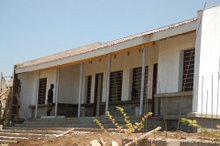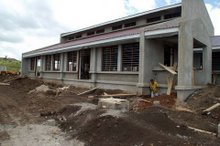Less than 48 hours ago, we climbed into our vans to head out of the city of Arusha. We headed west - past the PHS site, past the Rugby Club, past the school where we held our teaching seminars. We turned north and started climbing in elevation until we were driving up a mountainside on a dirt road that was little more than a goat path through the brush.
Soon the only structures we saw were stick and mud bomas - the round huts built by the Maasai tribe of northern Tanzania. The only people we saw were Maasai, dressed in the traditional purple and red robes, except for the occasional touch of imported used clothing g from the States. We saw a child in a hooded winter jacket, a man with a Vanderbilt University sweatshirt, and a toddler in a sweatshirt (and nothing else) so dirty it was difficult to discern the familiar gloomy face of Eeyore, from Winnie the Pooh, on it.
The adults we saw wore intricate jewelry. The Maasai are known for their beadwork, and they wear beaded accessories all over their bodies. Anklets on both feet. Cuff bracelets on both arms - some as narrow as one-half inch, others covering nearly wrist to elbow. Necklaces of all lengths, colors, and styles. But the most elaborate pieces are reserved for the ears. Men and women alike pierce and stretch their earlobes, as well as pierce the sides and tops of their ears, so that 3 or 4 or 5 pieces of jewelry can be displayed on each ear.
Our host village for the experience was called Elewai - named for the thorny bushes which grow abundantly on the mountainside. The village welcomed us with open arms, huge smiles, and eager handshakes. With the exception of our guides, they spoke no English, but we understood they were happy to meet us and share their lives with us during our stay. The children clustered around us - some shyly, some eagerly, wanting to hold hands, wear our sunglasses, and - exhibiting their past experience with Westerners - wanting us to take their pictures and then show them the display. In a place with no mirrors, their delight in seeing themselves and each other knew no bounds.
Our group was split in two. One group spent the first day with the Maasai men, the other with the Maasai women. On the second day, we switched.
The group with the men learned how boys mature into manhood. At age 15, boys can become warriors. This is when they pierce their ears using a sharp knife, and when they are allowed to go in to the forest with the other warriors for what seems to be times of bonding or retreat.
Warriors can hunt, and during the time of being a warrior (age 15 - 40) each man has the experience of killing a lion as a sort of rite of passage. Our group hiked from the village farther up the mountain to a forested area, where we visited a campsite where warriors would stay. We were offered the chance to participate in a traditional warrior meal. We learned about medicinal plants the Maasai have learned to harvest and use. And we watched the warrior camaraderie as we whispered to one another, "can you believe it - here we are, American city-dwellers, on a mountain in Africa with Maasai warriors." Really, it was too much to grasp.
With the women, we learned beading, and each had the opportunity to make a bracelet, necklace, or anklet. Our work was very simple - listening to the chatter and laughter of the women as they tried to help our attempts was both humbling and motivating. We also had the opportunity to purchase beaded items they had made, and though they spoke no English and the only words we had learned in Maasai were hello and thank you, the women were hard bargainers who knew enough to get as much out of these white people as they could!
On our night there, we sang and danced with the villagers. They use no other instruments than their voices and the stomping of their feet. The beadwork jingled as they moved, and they sang and danced in turn - first the men, then the women, then the men again. The men performed incredible jumps, moving straight up and down, rising head and shoulders above the crowds. The women wore broad beaded collars which swayed back and forth rhythmically with the slightest movement of their shoulders. They encouraged us to dance along, putting the collars on our women and cheering with each attempt made to dance along.
Then, after quite awhile of their dancing, they asked us to sing. We wanted to find a song that had a corresponding dance, or at least movements; that everyone in the group knew, and that had a cheerful, upbeat melody and rhythm.
So.
Led by our kindergarten teachers, 15 Americans, on a mountainside lit only by the full moon and a sky full of bright stars, surrounded by Maasai men, women and children in traditional dress, with goats braying in the distance, sang "If You're Happy and You Know it."
Once again we were incredulous at what we were doing.
We followed our first number with rousing renditions of the Chicken Dance Song, and Row, Row, Row Your Boat. They didn't understand the concept of singing in rounds, and they laughed that one group was still singing when the rest of us were done. We sang America the Beautiful, but they seemed to prefer the lively children's songs, so we sang the "months of the year song' to the tune (and with the motions) of the Macarena, and then finished the set with an all-encompassing version of the Hokey Pokey.
We were exhausted, filthy, and possibly emotionally overwhelmed by the end of the experience. But we had made intercultural connections, shared ourselves, and learned more from experiencing two days in the lives of the Maasai than we ever could have in books or on TV.
We saw children covered with flies, stepped into the tiny huts plastered with mud and dung where up to 15 people sleep in an area smaller than many American closets. We used a guest bathroom - an outhouse of sorts with a wooden box built over a pit in the ground, surrounded by plastic sheets and a door that didn't really close. We passed around Purell after watching the Maasai blow their noses on the same unwashed hands that grasped ours in friendship. We experienced a way of life that is shrinking in today's world, and that which few outsiders are privileged to see. We witnessed a culture that has endured for centuries. Our hearts and minds were changed.
We put our whole selves in, now we have taken our whole selves out. Our world was turned around. And that is truly what it's all about.
Subscribe to:
Post Comments (Atom)




3 comments:
Hi! We are Ann and Rich Remijan. We both work with Cathy and Terry at Joseph Academy. We just want to let you know that we are very proud of you for what you are doing. We are trying our best to keep things going while you are gone. So far we have only bought four new transportation vehicles. Did you know Rolls Royce makes a van? Reasonably priced, too! Happy Fourth of July!
Wow is all I can say. You describe your experiences beautifully. My husband John and I laughed when we read the choice of songs. I ask that you come back to the states and share your stories so, perhaps, a little of their community spirit can enrich all of us. Bless you all. Jeanette Knill
Love it Karen, Thanks for the reminder of the experience and bringing me back again, to step away from our needy American ways!
Post a Comment